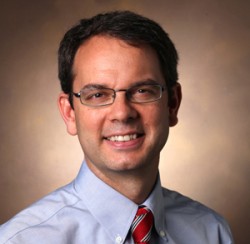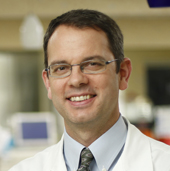The Department of Neurological Surgery has recruited John “Jay” Wellons III, M.D., MSPH, to serve as chief of Pediatric Neurosurgery.

“Dr. Wellons is one of the brightest lights in pediatric neurosurgery. He will transform the way we treat our tiniest patients,” said Reid Thompson, M.D., chair of Neurological Surgery.
Wellons comes to Vanderbilt from the University of Alabama at Birmingham with extensive expertise in hydrocephalus, minimally invasive endoscopic procedures, the surgical management of tumors of the central and peripheral nervous system and the treatment of brachial plexus nerve injury.
“The recruitment of Jay Wellons to lead the Children’s Hospital’s neurosurgical team is a wonderful testimony to the continuing growth in our surgical services,” said John W. Brock III, M.D., surgeon-in-chief for the Monroe Carell Jr. Children’s Hospital at Vanderbilt and vice-chair of Pediatric Surgical Services.
“Jay’s considerable experience in treating children with hydrocephalus and other neurological conditions allows us to expand not only areas of discovery but also in the daily clinical care of children with neurosurgical problems.
“We at Children’s Hospital are very excited about the tremendous opportunities for the growth and development of this program,” Brock said.
Wellons’ extensive research in hydrocephalus led to him co-founding the Hydrocephalus Clinical Research Network (HCRN), a national collaboration for multi-center trials in pediatric hydrocephalus.
He hopes to expand the program to include Vanderbilt as one of the national centers.
Wellons continues to serve as primary investigator for another prospective multi-center study on shunting outcomes in post-hemorrhagic hydrocephalus (SOPHH).
The study aims to standardize and compare the most common methods of surgical treatment of premature infants with hydrocephalus, potentially leading to better outcomes.
“The work we are doing in this area is fundamentally improving the care of children with this condition,” Wellons said.
Wellons is also researching the use of endoscopic procedures as an alternative to shunts.
The endoscopic third ventriculostomy inserts a tiny 4 mm instrument directly into one of the four fluid-filled ventricles in the brain to create an internal bypass and drain excess fluid caused by hydrocephalus.
In this procedure, no hardware is left behind and infectious issues are reduced.
“The challenge now is not how to perform the procedure, but who has the highest likelihood of success,” said Wellons. “Using mathematical models, we can show parents their child’s success right on a computer screen, including them in the treatment process.”
Wellons’ clinical research on repairing nerve damage is another area showing promise for improved recovery and functionality in the arm and hand following congenital or acquired nerve damage to the brachial plexus.
Surgery has already shown an impressive 80 percent recovery in eligible patients, so Wellons hopes to better identify those children who would be good candidates for the procedure, which if done sooner, could significantly improve outcomes.
“Vanderbilt already has an excellent foundation with a superb children’s hospital, highly supportive leadership, outstanding clinicians and a strikingly impressive research infrastructure,” said Wellons. “We are firmly on our way to developing a world-class pediatric neurological surgery program here. I’m very excited to lead this effort,” he said.















